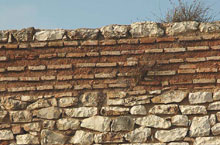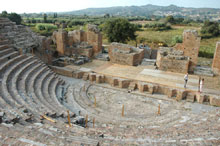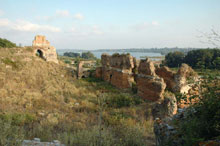To those familiar with Hellenistic antiquities, the visit to Nikopolis
is a unique experience. The archaeological site covers an area of approximately
350 acres; however, many parts of this area are used for agriculture and
thus only islets of archaeological finds survive. Large parts of the walls
of the 6th century’s East Roman state (which later would become Byzantium)
stand to this day, and create a rather unique impression to the modern
viewer.
 |
 |
| The impressive walls built in the
6th century A.D. and surrounded the city. |
| |
The Conservatory of Nikopolis
 |
| The Conservatory of Nikopolis |
The Conservatory of Nikopolis is the highlight amongst the ancient monuments
of the city, as it stands almost intact. It was probably used also as a
parliament, but its main use was for cultural events in the period where
Augustus introduced the “New Actia” festival, which would take place every
four years.
The auditorium of the Conservatory is divided in 19 rows of
seats and two flights of steps. The Festival of the Municipality of Preveza
takes place there today.
 |
 |
| The Conservatory, a jewel of Roman architecture,
built almost on the centre of the Roman Nikopolis, hosts today cultural
events |
| |
The ancient theatre
The ancient Theatre of Nikopolis, which lies outside the walls, at a distance
of 1.5 kilemeters from Nikopolis village. To construct the auditorium,
apart from the inclination of the ground, technicians used supporting walls
and buttresses. Today, however, the theatre is not preserved and little
remains from its former glory.
 |
 |
| The ancient theatre of Nikopolis,
from the seats of which viewers enjoyed a panoramic view over the
Gulf of Amvrakikos. Parts of the theatre along with other sections
of the archaeological site were transferred to Preveza by Ali Pasa,
who used them to build his palace. |
| |